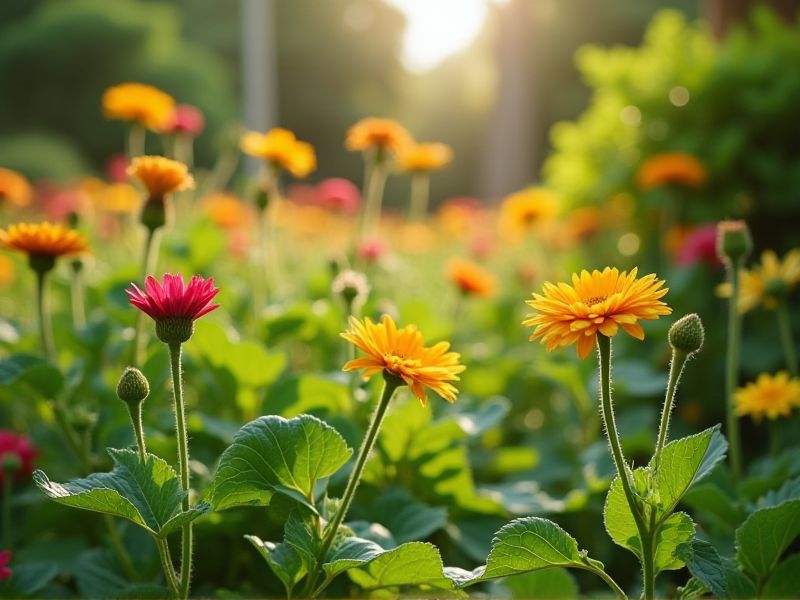
Fast-growing plants that thrive in heat include sunflowers, zinnias, and certain varieties of basil. Sunflowers (Helianthus annuus) can reach impressive heights within just a few months, making them perfect for summer gardens. Zinnias are vibrant annuals that bloom profusely, attracting bees and butterflies while tolerating high temperatures. When it comes to herbs, heat-loving basil (Ocimum basilicum) not only grows rapidly but also enhances your culinary dishes with its aromatic leaves. These selections not only add beauty to your garden but also support local ecosystems and provide edible benefits.
List of some Fast-growing plants that thrive in heat
- Bougainvillea (Bougainvillea spp.)
- Mexican Sunflower (Tithonia diversifolia)
- Lantana (Lantana camara)
- Canna Lily (Canna indica)
- Sunflower (Helianthus annuus)
- Passionflower (Passiflora incarnata)
- Zinnia (Zinnia elegans)
- Nasturtium (Tropaeolum majus)
- Hibiscus (Hibiscus rosa-sinensis)
- Marigold (Tagetes spp.)
Important things about Fast-growing plants that thrive in heat
Native Species Adaptation
Fast-growing native species such as the goldenrods and wild sunflowers are exemplary plants that excel in high-heat environments. These resilient species are well-adapted to withstand extreme temperatures due to their deep root systems, which help them access moisture even in dry conditions. You can benefit your garden and local ecosystem by incorporating these plants, as they improve soil health and attract essential pollinators like bees and butterflies. Emphasizing biodiversity, these native species support wildlife while requiring less water and fewer resources than non-native varieties.
Drought Tolerance
Fast-growing plants like Agave, Sedum, and Echinacea are not only resilient but also thrive in hot, drought-prone environments. These drought-tolerant species exhibit unique adaptations, such as deep root systems and water-storing tissues, allowing them to survive prolonged periods of heat with minimal water. Incorporating such plants into your landscape not only enhances its aesthetic appeal but also reduces the need for irrigation, making them an eco-friendly choice. By selecting heat-loving varieties, you can create a sustainable garden that flourishes even under extreme conditions.
Seasonal Growth Patterns
Fast-growing plants that thrive in heat include species like Sunflower (Helianthus annuus) and Zinnias, which can rapidly reach maturity during warmer months. These plants often prefer well-draining soil with full sun exposure, making them ideal for summer gardens. Utilizing their resilience, you can create vibrant landscapes or productive vegetable patches with varieties like Okra and Melons, which flourish under high temperatures. By choosing heat-tolerant species, your garden can benefit from extended blooming periods and abundant harvests, maximizing growth potential throughout the season.
Soil Requirements
Fast-growing plants that thrive in heat, such as sunflowers, zinnias, and certain varieties of basil, require well-draining soil rich in organic matter. pH levels between 6.0 and 7.0 are optimal to ensure nutrient availability, promoting robust growth. Incorporating compost or aged manure can enhance soil fertility and moisture retention, providing essential nutrients during high-temperature periods. You should regularly check for proper soil moisture levels to prevent stress, as these plants benefit from consistent watering, particularly during dry spells.
Sunlight Exposure
Fast-growing plants that thrive in heat, such as sunflowers and zinnias, require abundant sunlight to reach their full potential. These species typically prefer full sun, meaning they need at least six hours of direct sunlight per day to promote photosynthesis and healthy growth. Moreover, heat-tolerant varieties exhibit resilience against high temperatures, making them ideal for summer gardens. Incorporating these sun-loving plants into your landscape not only enhances aesthetic appeal but also contributes to improved biodiversity and habitat for pollinators.
Watering Needs
Fast-growing plants that thrive in heat, such as zinnias, sunflowers, and marigolds, require consistent watering to support their rapid growth. These heat-loving plants typically flourish in well-draining soil, making it essential to establish a deep watering schedule that encourages strong root development. During hot summer months, aim to water them early in the morning or late in the evening to minimize evaporation and maximize water absorption. Monitor the soil moisture regularly, ensuring it remains consistently damp but not waterlogged, as this balance promotes healthy, vibrant foliage and flowers.
Pest Resistance
Fast-growing plants that thrive in heat, such as sunflowers and zinnias, exhibit remarkable pest resistance due to their vigorous growth and robust foliage. These plants often produce natural compounds that deter harmful insects, reducing the need for chemical pesticides in your garden. Their ability to adapt to high temperatures allows them to flourish in summer conditions, making them ideal for warm climates. Incorporating these resilient species into your landscape not only enhances aesthetic appeal but also supports biodiversity by providing habitats for beneficial insects.
Fertilization Methods
Fertilization methods for fast-growing plants that thrive in heat can significantly enhance their growth and resilience. Organic fertilizers, such as compost and well-rotted manure, improve soil structure and supply essential nutrients while retaining moisture, crucial for plants in hot climates. Liquid fertilizers, including fish emulsion or seaweed extracts, provide quick nutrient uptake, promoting rapid growth during the heat and drought periods. Regularly monitoring soil pH and nutrient levels ensures that your plants receive the optimal fertilization needed for robust development in challenging temperatures.
Pruning Techniques
Pruning techniques are essential for maintaining fast-growing plants that thrive in heat, such as hibiscus, lantana, and bougainvillea. Regular pruning encourages bushier growth and enhances air circulation, reducing the risk of fungal diseases common in hot climates. By removing dead or overgrown branches, you promote healthier flowering and ensure that energy is directed towards the most vigorous parts of the plant. Implementing these pruning strategies not only optimizes the aesthetic appeal of your garden but also supports the longevity and resilience of your heat-tolerant plants.
Climate Resilience
Fast-growing plants such as sunflowers, zinnias, and millet are optimal choices for enhancing climate resilience in heat-affected areas. These species exhibit exceptional drought tolerance and rapid growth rates, making them vital for combating soil erosion and improving biodiversity. By incorporating these plants into your landscape, you can create a more sustainable environment that supports local wildlife and reduces water usage. Moreover, their ability to flourish in extreme temperatures helps mitigate the effects of climate change, allowing ecosystems to adapt more successfully.
